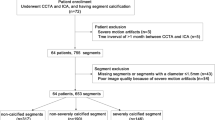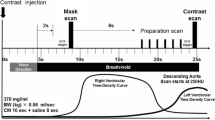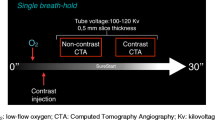Abstract
Objectives
Diagnostic accuracy of conventional coronary CT angiography (CCTAconv) may be compromised by blooming artifacts from calcifications or stents. Blooming artifacts may be reduced by subtraction coronary CT angiography (CCTAsub) in which non-contrast and contrast CT data sets are subtracted digitally. We tested whether CCTAsub in patients with severe coronary calcification or stents reduces the number of false-positive stenosis evaluations compared with CCTAconv.
Methods
In this study, 180 symptomatic patients scheduled for invasive coronary angiography (ICA) were prospectively enrolled and CT scanned (2013-2016) at three international centers. CCTAconv, and CCTAsub data sets were reconstructed. Target segments were defined as motion-free coronary segments with a suspected stenosis (> 50% of lumen) potentially due to blooming of either calcium or stents. Target segments were evaluated with respect to misregistration artifacts from the CCTAsub reconstruction process, in which case evaluation was omitted. CCTAsub and CCTAconv were compared with ICA. Primary outcome measure was the frequency of false positives by CCTAconv versus CCTAsub to identify > 50% coronary stenosis by ICA on a per-segment level.
Results
After exclusion of 76 patients, 104 (14% females) with mean age 67 years and median Agatston score 852 were included. There were 136 target segments with misregistration and 121 target segments without. Accuracy calculations in target segments without misregistration showed a reduction of the false positives from 72% [95% confidence interval (CI): 63-80%] in CCTAconv to 33% (CI:25-42%) in CCTAsub, at the expense of 7% (CI:3-14%) false negatives in CCTAsub.
Conclusions
In severely calcified coronary arteries or stents, CCTAsub reduces the false-positive rate in well-aligned, calcified or stent segments suspected of significant stenosis on CCTAconv. Nevertheless, misregistration artifacts are frequent in CCTAsub.
Key Points
• A high calcium-score reduces the diagnostic accuracy in patients scanned with cardiac CT.
• These patients would normally need an invasive angiogram for diagnosis.
• In this prospective, multicenter study, subtraction CT, when evaluable, reduces false-positive stenosis evaluations.
• Subtraction coronary CT angiography may, when evaluable, reduce excessive downstream testing.





Similar content being viewed by others
Abbreviations
- AIDR3D:
-
Adaptive iterative dose reduction 3D
- CAD:
-
Coronary artery disease
- CCTA:
-
Coronary computed tomography angiography
- CI:
-
Confidence interval
- CTDSA:
-
Computed tomography digital subtraction angiography
- ICA:
-
Invasive coronary angiography
References
Montalescot G, Sechtem U, Achenbach S et al (2013) 2013 ESC guidelines on the management of stable coronary artery disease: the task force on the management of stable coronary artery disease of the European Society of Cardiology. Eur Heart J 34:2949–3003
Cury RC (2014) President's page: coronary CT angiography as a gatekeeper to the catheterization laboratory. J Cardiovasc Comput Tomogr 8:480–482
Kuhl JT, Hove JD, Kristensen TS et al (2017) Coronary CT angiography in clinical triage of patients at high risk of coronary artery disease. Scand Cardiovasc J 51:28–34
Fuchs A, Kuhl JT, Chen MY et al (2015) Feasibility of coronary calcium and stent image subtraction using 320-detector row CT angiography. J Cardiovasc Comput Tomogr 9:393–398
Tanaka R, Yoshioka K, Muranaka K et al (2013) Improved evaluation of calcified segments on coronary CT angiography: a feasibility study of coronary calcium subtraction. Int J Cardiovasc Imaging 29(Suppl 2):75–81
Vilades MD, Leta R, Alomar SX, Carreras CF, Pons-Llado G (2016) Reliability of a new method for coronary artery calcium or metal subtraction by 320-row cardiac CT. Eur Radiol 26:3208–3214
Yoshioka K, Tanaka R, Takagi H et al (2016) Diagnostic accuracy of a modified subtraction coronary CT angiography method with short breath-holding time: a feasibility study. Br J Radiol 89:20160489
Yoshioka K, Tanaka R, Nagata K et al (2016) Modified subtraction coronary CT angiography method for patients unable to perform long breath-holds: a preliminary study. Acad Radiol 23:1170–1175
Amanuma M, Kondo T, Sano T et al (2016) Assessment of coronary in-stent restenosis: value of subtraction coronary computed tomography angiography. Int J Cardiovasc Imaging 32:661–670
Amanuma M, Kondo T, Sano T et al (2015) Subtraction coronary computed tomography in patients with severe calcification. Int J Cardiovasc Imaging 31:1635–1642
Yoshioka K, Tanaka R, Muranaka K (2012) Subtraction coronary CT angiography for calcified lesions. Cardiol Clin 30:93–102
Yoshioka K, Tanaka R (2011) Subtraction coronary CT angiography for the evaluation of severely calcified lesions using a 320-detector row scanner. Curr Cardiovasc Imaging Rep 4:437–446
Razeto M, Mohr B, Arakita K et al (2014) Accurate, fully automated registration of coronary arteries for volumetric CT digital subtraction angiography, Proc. SPIE 9034, Medical Imaging 2014: Image Processing, 90343F
Crum WR, Griffin LD, Hill DL, Hawkes DJ (2003) Zen and the art of medical image registration: correspondence, homology, and quality. NeuroImage 20:1425–1437
Leipsic J, Abbara S, Achenbach S et al (2014) SCCT guidelines for the interpretation and reporting of coronary CT angiography: a report of the Society of Cardiovascular Computed Tomography Guidelines Committee. J Cardiovasc Comput Tomogr 8:342–358
Sorensen SK, Kuhl JT, Fuchs A et al (2017) Volume and dimensions of angiographically normal coronary arteries assessed by multidetector computed tomography. J Cardiovasc Comput Tomogr 11:295–301
Larsen LH, Kofoed KF, Dalsgaard M et al (2013) Assessment of coronary artery disease using coronary computed tomography angiography in patients with aortic valve stenosis referred for surgical aortic valve replacement. Int J Cardiol 168:126–131
Andrew M, John H (2015) The challenge of coronary calcium on coronary computed tomographic angiography (CCTA) scans: effect on interpretation and possible solutions. Int J Cardiovasc Imaging 31(Suppl 2):145–157
Rabbat MG, Berman DS, Kern M et al (2017) Interpreting results of coronary computed tomography angiography-derived fractional flow reserve in clinical practice. J Cardiovasc Comput Tomogr S1934-5925(17):30161–30162. https://doi.org/10.1016/j.jcct.2017.06.002
Acknowledgements
The authors thank project nurses Christina Møller and Bente Andersen for excellent assistance.
Funding
The authors state that this work has not received any funding.
Author information
Authors and Affiliations
Corresponding author
Ethics declarations
Guarantor
The scientific guarantor of this publication is tenured senior author: Klaus Fuglsang Kofoed.
Conflict of interest
The authors of this manuscript declare no relationships with any companies, whose products or services may be related to the subject matter of the article.
Statistics and biometry
Lene Theil Skovgaard, Associate Professor at the Department of Biostatistics, University of Copenhagen, kindly provided statistical advice for this manuscript.
Informed consent
Written informed consent was waived by the Institutional Review Board.
Ethical approval
Institutional Review Board approval was obtained.
Methodology
• prospective
• diagnostic or prognostic
• multicentre study
Rights and permissions
About this article
Cite this article
Fuchs, A., Kühl, J.T., Chen, M.Y. et al. Subtraction CT angiography improves evaluation of significant coronary artery disease in patients with severe calcifications or stents—the C-Sub 320 multicenter trial. Eur Radiol 28, 4077–4085 (2018). https://doi.org/10.1007/s00330-018-5418-y
Received:
Revised:
Accepted:
Published:
Issue Date:
DOI: https://doi.org/10.1007/s00330-018-5418-y




